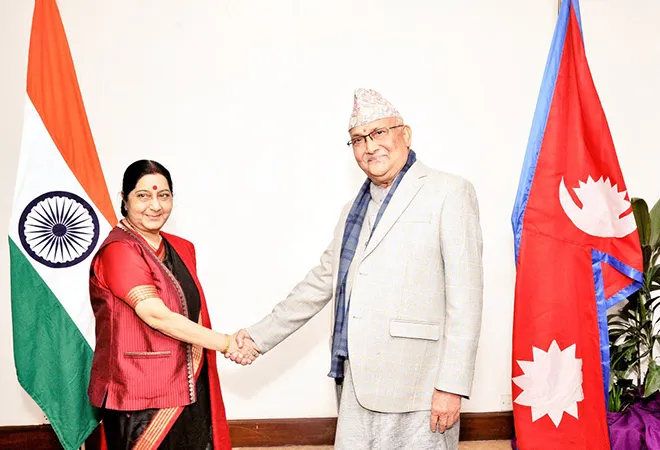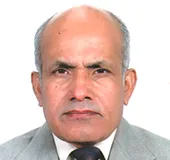-
CENTRES
Progammes & Centres
Location

During her two-day good-will visit to Nepal on February 1 and 2, India’s Foreign Minister Sushma Swaraj did all that India could have done to rebalance India’s relations with Nepal. The relations between the two countries had touched its lowest ebb in 2015-16 when KP Sharma Oli, the leader of the Communist Party of Nepal –Unified Marxist-Leninist (CPN-UML), was Prime Minister of the country. In the recently held elections at the local, provincial and central level, Oli’s party has won a resounding victory. In view of this reality, Swaraj focused more on mending relations with the CPN-UML, and particularly with its supreme leader KP Sharma Oli, the Prime Minister in waiting in Nepal.
But then, Swaraj did not overlook other political players in Nepal, either. Her meeting with the Madheshi leaders, apart from her meeting with President Bidya Devi Bhandari, caretaker Prime Minister Sher Bahadur Deuba and Communist Party of Nepal–Maoist Centre (CPN-MC) leader Pushpa Kamal Dahal, was also given equal importance.
Before the visit of Sushma Swaraj to Kathmandu, Indian Prime Minister Narendra Modi had congratulated KP Sharma Oli immediately after his party won a landslide victory in the elections in Nepal. He also expressed his keen desire to maintain working relations with the left front government in the country. As if this was not enough, he also gave a call to Oli the second time and invited him to visit India.
In return, Oli also invited Indian Prime Minister Modi to visit Janakpur and Muktinath, the two most important pilgrimage centres for the Hindus, in Nepal. During his second visit to Nepal in 20014, Modi wanted to visit these two places, apart from Lumbini – the birthplace of Lord Buddha. But the visit was aborted by certain elements who wanted to create a thaw in Nepal-India relations.
Initial gesture exhibited by India to develop working relations with Nepal’s democratically elected government is commendable. That is why, in the recent 2018 budgetary allocation for the neighbouring countries, the Indian government almost doubled the aid amount from IRs. 375 crores to Rs. 650 crores meant for different schemes and development projects in Nepal.
It is not for the first time that India will have to work with the left front government in Nepal. In 1994-95, India worked well with the government headed by communist leader Man Mohan Adhikari. Even afterwards India had worked with Maoist leader Pushpa Kamal Dahal twice when he was Prime Minister in 2008-09 and 2016-17. Subsequently, India also worked with governments headed by CPN-UML leader Madhav Kumar Nepal (2009-11), CPN-UML leader Jhal Nath Khanal (2011), Maoist leader Baburam Bhattarai (2011-13) and KP Sharma Oli (2015-16).
However, in certain quarters it is feared that the left front government this time might not be of the same nature as the previous ones. KP Sharma Oli, who for a long time had the reputation of being a pro-Indian element in Nepal, all of a sudden turned his leanings towards China, particularly during the constitution-making period (2015) and after he became the Prime Minister in 2015-16.
Unfortunately, Oli had developed certain misconceptions that the Madhesh agitation and the five-month-long economic blockade in 2015-16 were instigated by New Delhi. It took him quite some time to understand that the agitation and the economic blockade had been engineered by the Madhesh-based political parties in their bid to end discriminatory practices in the Nepalese constitution, and that New Delhi had nothing to do in some of those affairs.
He could be convinced of this reality only when he visited India as the Prime Minister in early 2016 when he publicly acknowledged that all of his misconceptions about New Delhi were clear.
Nevertheless, Oli tried to push the country closer to the Chinese axis by signing 10 point agreement with China with the purpose of bringing China’s railway inside the Nepalese territory and using Chinese port for trade with third countries. Even more recently, after winning the elections of the Nepalese parliament, he not only visited Kerung-Rasuwagadhi border between Nepal and Tibet (China) and vowed to expand the road from the border point to other parts of Nepal, but he even went to the extent of making it public that he would reinstate the rejected Chinese company in Budhikandaki project once he came to power. It is also to be noted that Pushpa Kamal Dahal, the other partner of the left alliance, signed the Belt & Road Initiative with China last year to pave the way for greater Chinese investment in Nepal.
Today, China has emerged as one of the power centres that cannot be so easily ignored in Nepal. As ever before, China will like to dwarf India’s influence in Nepal. On top of this, the West has also made its strong dent in Nepal through its network of hundreds of INGOs and thousands of NGOs whose total budget is on par with the budget of Nepal government itself. Unfortunately, many of those INGOs/NGOs, though opposed to China, are not friendly to India either.
Massive efforts made by those unbridled INGOs/NGOs in influencing the political leaders, particularly from the left front, and converting people to alien faith will have its effects in bringing a thaw in the relations between Nepal and India.
In such a situation, merely conducting a high-level visit to Nepal by the Indian political leaders, such as that of Foreign Minister Sushma Swaraj or Prime Minister Narendra Modi, will not be enough. India will need to have far more engagement with Nepal both at Track I and Track II levels. Also, what is necessary for India to do is to revamp its working style in Nepal.
India’s comparative advantage in Nepal is its soft power and the people-to-people relations in all important fields. The geography, culture, religion and open border system between the two countries have bound the two countries together since time immemorial. Now time is ripe for India to cultivate in some of these fronts.
Sadly though, India’s working style in Nepal is not much different from what it was in the 1950s when China was not a factor to be reckoned with and also that the West did not have much of the clout in this country. Perhaps, very few people in India are as much aware of some of these present-day realities as Sushma Swaraj. This is not merely because she travelled to Nepal seven times during her tenure as Foreign Minister, but also because she is a very senior politician and statesperson of the country and has built up a personal rapport with leaders from each political parties in Nepal.
Can it be expected from Sushma Swaraj if she could bring about structural reforms in India’s foreign policy vis-à-vis Nepal? May she do something to boost up Nepal-India relations by bringing the fruits of India’s fastest economic growth to this country? Given the fact that Narendra Modi’s government in India prioritises neighbourhood first policy, Swaraj could take a fresh initiative to strengthen and consolidate the Nepal-India relations partly by fostering greater cooperation in the development sector and partly by diluting negative factors that have proved the bottleneck in revamping the age-old relations between the two countries. At a time Modi is likely to visit Nepal in near future, such efforts to be made by Swaraj could prove the milestone in the Nepal-India relations.
The views expressed above belong to the author(s). ORF research and analyses now available on Telegram! Click here to access our curated content — blogs, longforms and interviews.

Hari Bansh Jha was a Visiting Fellow at ORF. Formerly a professor of economics at Nepal's Tribhuvan University, Hari Bansh’s areas of interest include, Nepal-China-India strategic ...
Read More +